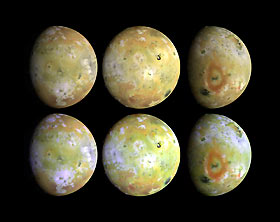
Enregistrez gratuitement cette image
en 800 pixels pour usage maquette
(click droit, Enregistrer l'image sous...)
|
|
Réf : S02435
Thème :
Planètes et lunes (174 images)
Titre : Full Disk Views of Io
Description : (La description de cette image n'existe qu'en anglais)
Three views of the full disk of Jupiter's volcanic moon, Io, each shown in natural and enhanced color. These three views, taken by Galileo in late June 1996, show about 75 percent of Io's surface. North is up. The top disks are intended to show the satellite in natural color (but colors will vary with display devices) while the bottom disks show enhanced color (near-infrared, green, and violet filtered images) to highlight details of the surface. These images reveal that some areas on Io are truly red, whereas much of the surface is yellow or light greenish. (Accurate natural color renditions were not possible from the Voyager images taken during the 1979 flybys because there was no coverage in the red.) The reddish materials may be associated with very recent fragmental volcanic deposits (pyroclastics) erupted in the form of volcanic plumes. Dark materials appear in flows and on caldera floors. Bright white materials correspond to sulfur dioxide frost, and bright yellow materials appear to be in new flows such as those surrounding Ra Patera. The red material may be unstable since the color appears to fade over time. This fading appears to occur most rapidly in the equatorial region and more slowly over the polar regions; surface temperature may control the rate of transformation. Comparisons of these images to those taken by the Voyager spacecraft 17 years earlier have revealed that many changes have occurred on Io. Since that time, about a dozen areas at least as large as the state of Connecticut have been resurfaced. Io's diameter is 3,632 km.
|
|

